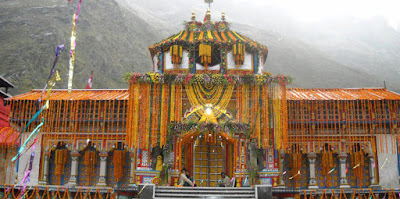Badrinath Temple
Badrinath Temple
About
Badrinath temple is situated in Uttarakhand(North India).Badrinath is a Hindu temple dedicated to the Lord Vishnu which is situated in the town of the Badrinath in Uttarakhand.The temple and town form one of the four Char Dham and Chota Char Dham pilgrimages site.The temple is also one of the 108 Divya Desam dedicated to the Lord Vishnu.Who is worshipped at Badrinath holy shrines Vaishnavities.It is open for Six years because of extreme weather conditions in the Himalayan region.The Temple is a located in Gharwal hill track in the Chamoli district along the bank of the Alaknanda River at an Elevation of 3,133 above the mean the sea level.it is one of the pilgrimages in India having records, 1060000 visitors.
The image of the presiding deity worshipped in the temple is a 1m tall, black stone statue of Lord Vishnu in the form of the Badrinarayan.The statue is a considered by many Hindus to be one of the eight swayam vyakta kshetra, or self-manifested statues of the Lord Vishnu.
The temple is a mentioned in ancient religious text like Vishnu Purana and Skanda Purana.It is the glorified in the Divya prabandha an early medieval Tamil canon of the Azhar saints from the 6th to 9th centuries AD.
There is no historical record of the temple, but there is mention of the presiding deity Badrinath in Vedic scriptures, indicating the presence of the temples during the Vedic period.according to some accounts, the temples were a Buddhist shrine till the 8th century and Adi Shankara converted it to a Hindu temple.The architecture of the temple resembling that of a Buddhist vidhara and the brightly painted facade which is a typical of the Buddhist temples to the leads to the argument other accounts relate that it was originally established as a pilgrimage site by Adi Shankara in the ninth century.
The image of the presiding deity worshipped in the temple is a 1m tall, black stone statue of Lord Vishnu in the form of the Badrinarayan.The statue is a considered by many Hindus to be one of the eight swayam vyakta kshetra, or self-manifested statues of the Lord Vishnu.
The temple is a mentioned in ancient religious text like Vishnu Purana and Skanda Purana.It is the glorified in the Divya prabandha an early medieval Tamil canon of the Azhar saints from the 6th to 9th centuries AD.
Pilgrim
Devotees of all the faith and all school of thought of the Hinduism visit the Badrinath temple.All the major majestic insition of the Kashinath Jeeyar mutt Udupi pejawar and Mathralayam Shri Raghavendra Swamy Mutts have their branches and guest house there.
The Badrinath temple is one of the five related shrines called panch Badri.Which are dedicated to the Worshipped to the Lord Vishnu The five temples are Vishal Badri-Badrinath temple in Badrinath Yoghadayan Badri located at the Pandukeshwar, Bhavisya Badri located 17 KM temples from Jyoti Mutt at subain, Vridh Badri located 7 km from Jyotimuth in Animath and Adi Badri located 17 km from Karanprayag.The temple is considered as one of the holiest Hindu Char Dham sites, comprising, Rameswaram, Badrinath, Puri, and Dwarka.Although the Temple origin is not clearly known, the Advaita school of the Hinduism established by the Adi Shankara attributes the origin of the Char Dham to the sheer.The four monasteries are located across the for corners of the India and their attendant temples of the Badrinath at Badrinath temple in Badrinath in the North, Jagannath temple in the east.
The journey across the four cardinal points in India is considered sacred by the Hindu, who aspire to visit these temples once in their lifetimes.Traditionally, the pilgrimages start at the eastern end of the Puri, Proceeding clockwise in a manner typically followed by circumstances in Hindu temples.
 |
| Pilgrimage |
The journey across the four cardinal points in India is considered sacred by the Hindu, who aspire to visit these temples once in their lifetimes.Traditionally, the pilgrimages start at the eastern end of the Puri, Proceeding clockwise in a manner typically followed by circumstances in Hindu temples.
History
 |
| History |



Comments
Post a Comment